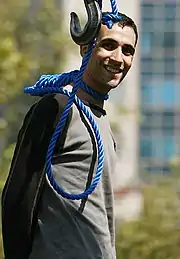Majid Kavousifar
Majid Kavousifar (Persian: مجید کاووسیفر) was an Iranian who, with his nephew Hossein Kavousifar, was convicted of the murder of Judge Masoud Ahmadi Moghaddasi.[1] Majid and Hossein Kavousifar were both publicly executed by hanging in Tehran in August 2007.[1]
Majid Kavousifar | |
|---|---|
| مجید کاووسیفر | |
 Kavousifar moments before his execution in Tehran | |
| Born | 1978 or 1979 |
| Died | August 2, 2007 (aged 28) Tehran, Iran |
| Cause of death | Execution by hanging |
| Criminal status | Executed |
| Conviction(s) | Murder (3 counts) Armed robbery (8 counts) Illegal firearms possession Illegal drug use |
| Criminal penalty | Death |
Murder of Islamic Republic Judge Masoud Ahmadi Moghaddasi
Masoud Ahmadi Moghaddasi was one of several judges of Iran's Islamic Revolutionary Court, that collectively sentenced more than 2800 to 3800 [2] political prisoners to execution during the 1988 executions of Iranian political prisoners.[3] The mass executions were largely thought to be a political purge with Operation Mersad preceding the executions. Judge Moghaddasi also presided over the trials of Iranian political dissidents, such as Akbar Ganji.[4]
As Judge Moghaddasi was leaving a court building in Tehran on 2 August 2005, an assailant on a motorcycle shot the judge twice with a pistol, killing him.[5] That assailant was subsequently identified as Majid Kavousifar.[6]
Escape from Iran, and arrest
After murdering Judge Moghaddasi, Majid Kavousifar escaped from Iran to United Arab Emirates and went to the United States embassy to apply for refugee status. Instead, the embassy surrendered him to Emirati police, and the UAE extradited Kavousifar to Iran in 2006.[4]
Trial
After their arrest, Iran's Ministry of Intelligence interrogated the Kavousifars, and determined that the duo murdered Judge Moghaddasi because of personal motivations, and not for political reasons. Majid confessed to the murder of Judge Moghaddasi after three hours of interrogation.[4]
Majid and Hossein Kavousifar were tried before Branch 15 of the Revolutionary Court in Tehran. Majid testified in court to killing Judge Moghaddasi, claiming that his motive was because the judge had wrongly convicted him of alcohol possession (which is a crime under Iran's version of Islamic law) on a previous occasion. During that previous trial, Judge Moghaddasi sentenced Majid to be whipped, but subsequently reduced his punishment to a cash fine.[4] Because of this experience, Majid concluded that Judge Moghaddasi was a corrupt and unjust judge, and retaliated by killing him.[4]
On 14 March 2007, the Revolutionary Court found Majid and Hossein Kavousifar guilty of spreading corruption of the earth, the murders of Judge Moghaddasi and the other two individuals, armed robbery, illegal possession of firearms, and other crimes, and sentenced them to the death penalty. In addition, the court sentenced Majid to a whipping of 74 lashes and a fine of one million tomans for illegal drug use.[4][7]
Execution

Majid and Hossein were both hanged in public on 2 August 2007, in front of the Ershad Judiciary Complex in central Tehran.[1] At the time, the Kavousifars' hangings were the first public executions carried out in Tehran in five years.[8] Majid and Hossein were hanged from ropes attached to five meter long cranes; however, both men were placed atop stools, which were pulled from under their feet at the moment of their execution. Majid appeared to die instantly, while Hossein struggled for a few moments before going limp. After several minutes, their bodies were removed and placed into an ambulance.[9]
Hossein Kavousifar appeared visibly distressed as he awaited his execution, but his uncle (Majid) gestured to him and smiled in an attempt to reassure him. Majid Kavousifar showed no remorse to Iranian police officers in his last words, telling them "I reached the point at which I decided to eradicate any injustice."[1] Majid was described in one report "as waving one hand from his handcuffs at his co-conspirator at the watching crowds" and making "a show of puffing out his chest, grinning at the crowds and even chatting to the burly black-clad executioner, in an apparent final check of the execution procedure."[9]
Internet popularity
Photos of Majid Kavousifar's execution went viral in the late 2010s with fictional stories like "a Christian got executed in a Muslim country" or "an Algerian hacker who was executed for stealing money from Israeli banks."[10][11]
References
- "Iran hangs judge's killers in public". Reuters UK. Retrieved 2015-10-13.
- Schwerin, Ulrich von (2015). The dissident mullah : Ayatollah Montazeri and the struggle for reform in revolutionary Iran. Londoc=913788038. ISBN 978-1-78453-173-7. OCLC 913788038.
{{cite book}}: CS1 maint: location (link) CS1 maint: location missing publisher (link) - "gooya news :: politics : ترور قاضي مسعود احمدي مقدس: ارتباط با اعدام هاي دهه شصت، پرونده هاي منکراتي يا پرونده گنجي؟". news.gooya.com. Retrieved 2021-02-11.
- "The Murderers of Judge Ahmadi Moghaddas were Executed". BBC Persian. 2 August 2007. Retrieved 27 January 2022.
- "Judge shot dead in car by motorcycle gunman". thetimes.co.uk. The Times. Retrieved 27 January 2022.
- "Iran's Rulers Revel in Rough Justice". The Scotsman. Retrieved 27 January 2022.
- "Death penalty for the confessed killers of Judge Moghaddas". BBC Persian. Retrieved 27 January 2022.
- "2007: Majid and Hossein Kavousifar". ExecutedToday.com. Retrieved 27 January 2022.
- "Iran publicly hangs killers". news24.com. Retrieved 27 January 2022.
- "Often-misused photo of 2007 public execution in Iran - not man executed in Syria for 'preaching gospel'". Retrieved 27 January 2022.
- Dube, Tendai. "This man was executed for murdering a judge in Iran, not preaching the gospel in Syria". factcheck.afp.com. AFP Fact Check. Retrieved 27 January 2022.